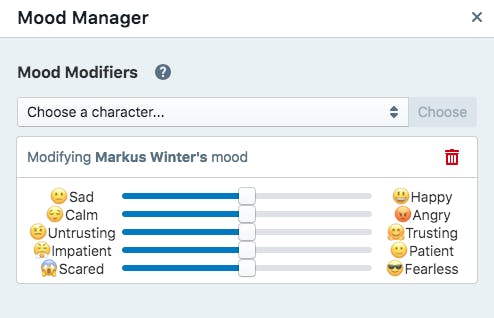In any good story, there is a journey. It is the challenges that the characters face and their emotional responses to that journey, that keep us on the edge of our seats, keen to find our what happens next.
Emotional sentience is a key part of Charisma.ai, as it brings our characters closer to the audience. In turn these leads to empathy that brings the whole interactive experience to life. Charisma.ai projects have character, and that is a game-changing difference between standard call centre chatbots, and what is possible when an interactive chatbot evolves its emotions.
To do this in Charisma.ai, the first step is to set up the default character state for each of your characters. This is an easy process that defines the mood state of that character at the beginning of the story. If a character is setup as being calm and humorous, it will respond accordingly as a base reaction. The second and final step in creating a character is to train it by chatting to it, and giving it as many sample responses to basic conversations as possible. For example, ‘How are you?” would be answered differently by a Disney character than by Hannibal Lector and a systems needs to recognize that.
Once the character has been trained (a process that should take around 5–10 minutes), its base personality and mood has been set.
Once you are in the writing mode, a character’s mood state can be changed in response to any piece of dialogue. It is natural that if a player insults one character in a room, other characters in the room should be able to react as well. To do this, click on the [heart] icon on a character dialogue node, and you will see a list of emotion sliders, and a drop-down of characters to choose from. Change the mood state using the sliders and this is automatically set.

TIP: Note that emotion states in Charisma.ai are incremental not absolute. This means that if a character is very angry, and then the slider on a piece of dialogue is set to very calm, that character will calm down, but not go straight to fully calm. This is important to have more naturally feeling characters rather than binary reactions, and again to allow users to build up their relationships with each character.
Finally, you can see the emotional state of any of your characters visualized about the storygraph screen. This lets you see how characters develop over the length of the story, and allows you to anticipate which storylines are likely to be triggered in the final version.
In summary, handling emotional states of chatbot characters is new area that is evolving rapidly, but is vital to be able to create a more realistic and immersive experience for users. Charisma.ai has put this feature to the forefront of the interface to promote its use by our writers and for all projects.